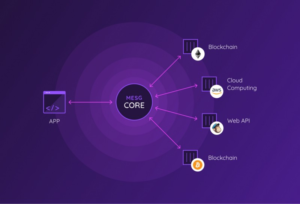One of the hottest trends in the technology sector today is blockchain, the decentralised technology underpinning bitcoin and other cryptocurrencies. While the disruptive tech is transforming the way businesses think about solutions for a variety of industry pain points, it brings with it a problem of its own. As more companies look to blockchain technology as a means of improving their current systems, they create new chains of their own from a long list of options available to them. Because different blockchain platforms are designed to tackle different issues, they come in a wide variety of shapes and sizes.
‘1,000 and 1 blockchains’
Often times we hear people talk about “the blockchain” as if there’s one singular chain everyone is taking advantage of to leverage for their own business needs. However, the truth is that there are hundreds of different blockchains in existence, and even more being created all the time. And with the growing popularity of blockchain solutions in the tech space, it’s likely that the number of different chains will only continue to expand.
Though the new disruptive tech is being adopted by various industries, businesses start running into problems when working with multiple blockchains in the same process. For example, if a company has instituted a decentralised alternative for managing their supply chain and logistics like the program created by IBM and Maersk, but have devised an entirely separate network for other steps along the production line like Rostec’s data management system utilising Waves, then communication can be difficult. Between all the decentralised moving parts in independent blockchain networks, companies need to spend a significant amount on specialised developers capable of orchestrating the necessary connectivity between these networks to keep operations moving.
Better together
Currently, there are some options for reaching greater cross-chain connectivity thanks in part to many projects connecting chains together.
Wanchain began tackling the issue years ago after completing its ICO in 2017. The company is focused on the financial sector and is building an entirely decentralised financial market with a distributed infrastructure. Using the Wancoin as an intermediary, the project is able to successfully facilitate exchanges across different blockchains and record all intra-chain and cross-chain transactions immutably. With the system, users are to exchange crypto assets from various blockchains (read: not all ERC-20 tokens) without the need for trusting a third-party to securely handle them. Instead, by creating a cross-chain solution which allows other blockchains to interact with each other and transfer assets, users get similar benefits and ease of use they would from an exchange but without the added security risk and for a reduced price. Without the need for an entire exchange with expensive overhead, Wanchain handles the connectivity between different chains.
Using Wanchain, companies can reduce blockchain development costs since there’s no longer a need to worry about connectivity and interoperability between chains. Instead, users can take advantage of Wanchain’s digital bridge between blockchains. But sometimes businesses need the ability to connect non-blockchain technology to their newly implemented blockchain solutions. If that’s the case, then other options are needed to bridge the larger technological gap.

One team specialising in this issue is MESG which has created a decentralised building platform for developers and businesses of all kinds to connect any technology. Blockchains, databases, web services, vehicles, video games, and much more in the ever-increasing Internet-of-Things (IoT) can all be connected, decentralised, and automated using MESG, regardless of the programming language. What companies are then left with is a powerful engine to connect all of their devices, systems, and networks in a simple way that is technology-agnostic. Unlike some of the other possible solutions, the new initiative is working to improve efficiency for businesses by cutting out the need for additional blockchain development which ultimately adds unneeded expenses and consumes more time than necessary.

Expanded connectivity
Because the world doesn’t operate in a bubble, there are other high-cost additions that come with the blockchain networks companies develop. Even with technology from ambitious projects like Wanchain and Polkadot, large data storage systems and supply chains — just two examples from an essentially innumerable amount of business operations — often include an expansive list of non-blockchain-based technology and equipment. To integrate new blockchain systems in with all of the existing systems is a few things, mainly: time-intensive, expensive, and not scalable to offer greater adoption easily in the long run.
Firstly, dedicated blockchain developers must build ways for their private or public chain to be connected with non-blockchain components. This takes up a lot of time and resources from the team that could be working on more crucial aspects of the system. Beyond concerning themselves with potential cross-chain questions, developers also need to account for the more traditional centralised components of the operations. All of that translates to more time and money being spent.
Secondly, when developers tackle the problems of connectivity, they’re doing so for their own systems. After all the time and funding spent creating a way for centralised and decentralised components to work together seamlessly, there’s no further application for other systems in the future. As blockchain technology continues to grow in the space, there’s no doubt that ease of use and accessibility are some of the highest factors for greater adoption, but how is that accomplished? The answer lies in cutting costs by creating a way for all components to connect and interact with each other easily without the need for excess spending.
When companies are equipped with a method of improving connectivity across all technologies — both cutting edge and legacy — the cost of blockchain integration will continue to decrease. Once developers no longer need to solve compatibility issues between the vast number of individual chains and all the preexisting systems businesses have in place today, they can focus on the needs of their own specific platform. In return, businesses can save money and spend resources on improving the network as a whole and leverage the power of platforms that connect technology rather than handling the connectivity on their own. For blockchain adoption to succeed and expand, businesses need an option for cost-effective integration with their currently in-use systems — now that’s becoming a reality.






